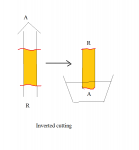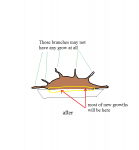bonhe
Masterpiece
It is insane idea, is not it? No, it is not! In other post http://www.bonsainut.com/threads/propagate-thick-olive-branch-by-cutting.14984/page-2, Si Nguyen mentioned my name in below reply:
"You might have your stump up side down, which is ok. I have one of those up-side-down stump olive bonsai. Bonhe ( a friend on here) introduced me to a friend in Corona, CA, who does a lot of these olive stumps. He would put the huge trunk section upside down and grow it into a masterpiece. Hard to believe until you see it for yourself."
I create this topic to answer the question of Hemmy.
It is a technique circulated in few Vietnamese bonsai people in Southern California for years. One of my best friend, MP, is a master in this technique. Like Si said, MP has produced so many masterpieces not only olive, but pomegranates as well. I know one of famous bonsai artist here had to acquire materials from MP. I deeply appreciate MP who taught me not only this technique but also others.
What is the inverted cutting? Please look at the below pictures for information.


Below picture shows the tree

The horizontal cut surface at the trunk base is at the soil line or a few centimeters below the soil line. Then the root system will be inverted and placed into the good drainage soil. I like to use pumice: mini pine bark with ratio 1:1.

Because it is really big cutting (the largest cutting, which I made, is about 60 cm diameter), we have to give it an excellent humidity environment. I use a big clear plastic bag which used to cover furniture for sale in the store to cover the cutting and the pot. The pot has to be placed in the shady site until the new shoots coming out. We need to observe the plastic bag daily. If there is a tine water drop inside the plastic bag, it means the soil is still wet. No need water at that time. The post care is very important for the success.
Question: why do we love to do the inverted cutting?
Bonhe
"You might have your stump up side down, which is ok. I have one of those up-side-down stump olive bonsai. Bonhe ( a friend on here) introduced me to a friend in Corona, CA, who does a lot of these olive stumps. He would put the huge trunk section upside down and grow it into a masterpiece. Hard to believe until you see it for yourself."
I create this topic to answer the question of Hemmy.
It is a technique circulated in few Vietnamese bonsai people in Southern California for years. One of my best friend, MP, is a master in this technique. Like Si said, MP has produced so many masterpieces not only olive, but pomegranates as well. I know one of famous bonsai artist here had to acquire materials from MP. I deeply appreciate MP who taught me not only this technique but also others.
What is the inverted cutting? Please look at the below pictures for information.


Below picture shows the tree

The horizontal cut surface at the trunk base is at the soil line or a few centimeters below the soil line. Then the root system will be inverted and placed into the good drainage soil. I like to use pumice: mini pine bark with ratio 1:1.

Because it is really big cutting (the largest cutting, which I made, is about 60 cm diameter), we have to give it an excellent humidity environment. I use a big clear plastic bag which used to cover furniture for sale in the store to cover the cutting and the pot. The pot has to be placed in the shady site until the new shoots coming out. We need to observe the plastic bag daily. If there is a tine water drop inside the plastic bag, it means the soil is still wet. No need water at that time. The post care is very important for the success.
Question: why do we love to do the inverted cutting?
Bonhe






